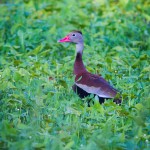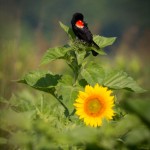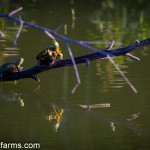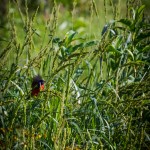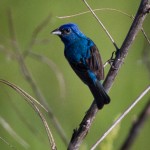This morning, Claudia and I walked the wetland trail. The tall grass on the trail was wet with dew, making the walk a bit uncomfortable for us. That moisture was just what the doctor ordered for the critters in the wetland. The first thing we spotted was a pair of Black Bellied Whistling Ducks.
Birds seemed to be everywhere but only the Redwinged Blackbirds and Indigo Buntings seemed to be especially visible. Here is a RWB perched next to a sunflower as if it can’t wait until the seeds mature and are ready to eat. This shot was taken in one of the three sunflower fields I planted around the house and shop though the RWB’s are abundant in the wetlands as well.
These baby turtles were taking advantage of the morning sun to warm up their skins after an unusually cool June night. We’ve had a nice spring this year with no 100 degree days as of the middle of June. This pond is a part of the wetland we created a few years ago and is designed to hold water all year around. The turtles have really thrived here as I sometimes count as many as 20 heads bobbing around in the water eating bugs. Below is a good page to read up on the Red Eared Sliders if you are interested.
http://en.wikipedia.org/wiki/Red-eared_slider
As always, the Painted Bunting is the star of the show. Just behind where the Whistling ducks were browsing, this beauty stopped for a quick meal of wild millet. They seem to love the border between the open moist soils area and the trees. This transition seems to offer abundant cover and plenty of food to much on. I estimate a ratio of about 20:1 between Indigo Buntings and Painted buntings on our place. We are on the far eastern border of the range of the Painted. If you want to see some really great pics of the Painted from last year, click below.
http://barrackfarms.com/wordpress/the-ultimate-spring-arrival/
The indigo Buntings are also a joy to watch. Much more plentiful than the Painted, they rule the wetlands. Along the 1/2 mile levee that defines the wetland, there must be dozens of pairs mating and nesting and singing their hearts out. The buntings don’t like to sit still for long so it is especially rewarding to get shots like these. Believe me, they are not easy to get!
I usually don’t get too excited about Cattle Egrets but they really are beautiful birds. They are also less skittish about having their picture taken than Great or Snowy egrets. This one wades, feeds and suns not far from the Whistling Duck in the first picture.

